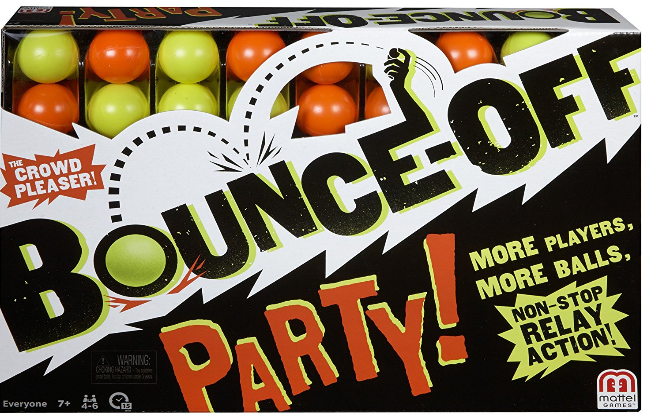 |
| Bounce-Off Party - Now up to six can play. |
This is a new version of Bounce-Off! that is geared toward group play, although Bounce-Off Party! can still be played by two. There are many similarities between Bounce-Off!, Bounce-Off Blow Out!, and Bounce-Off Party, and a few differences. They all have the same lightweight, easy to use grid, however the first two versions include one 6X6 grid, and the party version includes six 4X4 grids. They all have the same balls (colors vary) and the same type of ball tray. The Bounce-Off Party version includes pattern cards, like the original Bounce-Off! (Bounce-Off Blow Out! includes game mats instead of pattern cards).
The party version includes six grids because it is meant to be played by two teams of three. One person from each team goes head-to-head with a member from the opposing team. Each pair of players gets a pattern card and, playing simultaneously, they race to see who can make the pattern first by bouncing balls into their own grid. Here is a picture from the back of the box to help better explain. I have circled in blue two players that are racing to complete a pattern.
For therapeutic value, I don't like this 4X4 grid near as well. Only your own colored balls go onto your grid so it is much easier to see when you have completed the pattern (less challenging). With two colors on the same grid the background will include two color balls and if you get blocked, or don't get the spaces you wanted, you must be able to shift to Plan B, and maybe even Plan C. All while keeping track of your opponent and trying to block his win. A lot more strategy and visual perceptual skills involved in two people playing on the same grid. On the other hand, you need to be more precise with bouncing when the spaces around you are empty, and a 6X6 grid may "catch" a ball that wouldn't fall into the 4X4 grid.
Note that if you are playing with a person who takes awhile to get the hang of it you will be chasing after a lot of balls. Best not to use around dogs that like to chase balls as they will be easy to bite through and may be a choking hazard.
To read about several Bounce-Off games I have blogged about, click here.
Try this:
- Play 1:1 (you won't need a party:).
- Play with a beginner. The small grid with only one ball color may make it easier for him to see his pattern.
- Allow the beginner to place the balls in the grid to match a pattern card. Don't bounce, just concentrate on recognizing patterns first.
- Look at the pattern card before you begin. Set the balls in the grid to match the pattern. Turn the grid into different orientations and see what the pattern looks like from different angles so you can recognize when you have matched it.
- Give each player eight balls. Playing simultaneously, see who can get their eight balls into the grid first.
- Play alone and time yourself to see how long it will take you to get a ball into each space on the grid, 16 balls in all. Play again and try to beat your time.
- Bounce all the balls into the grid without a challenge card to practice just getting them into the grid. It takes a little forward push, aim, and graded force.
- Make your own design cards with new challenges.
- Stop the game for a moment when someone is getting close to winning. Ask him to point out on the grid the possibilities and where he will have to land the ball to make the pattern. See if he can pick the pattern out of the background and work on aiming for a specific location.
- Skip the pattern cards and play a game where players take turns bouncing in one ball at a time. First person to get 3 in a row, in any orientation, is the winner. Players could play together on one grid or each player could play on his own grid. The second option would be easier and you could use this game to practice for accuracy.
- Place the balls in the grid to match a pattern card. Add extra balls around it to make it more challenging if you want.Then give the card to the player and see if they can find the matching pattern on the grid. To make it more difficult, turn the grid so that it will not look exactly like the card. Let the individual turn the card if they need to for help, or don't.
- Follow the instructions from the suggestion above but instead of giving the player one card, give them several and ask them to find one that will match a pattern on the grid.
- Work
on eye-hand coordination, manual dexterity, motor planning, visual
discrimination, spatial relations, position in space, visual closure, figure ground,
process skills, executive functioning skills, socialization skills, play and
leisure exploration and participation
In the box: Six 4X4 plastic grids, 6 ball trays, 18 yellow balls, 18 orange balls, 15 pattern cards




No comments:
Post a Comment
Thank you for taking the time to comment.